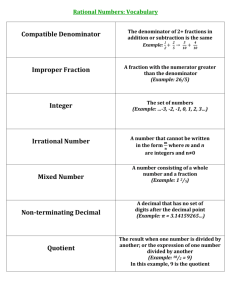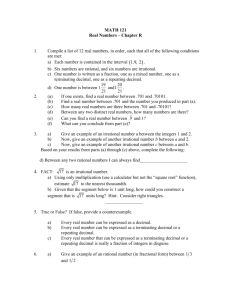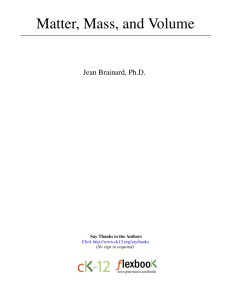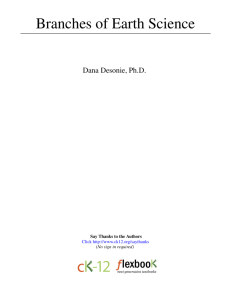Subsets of Real Numbers
advertisement
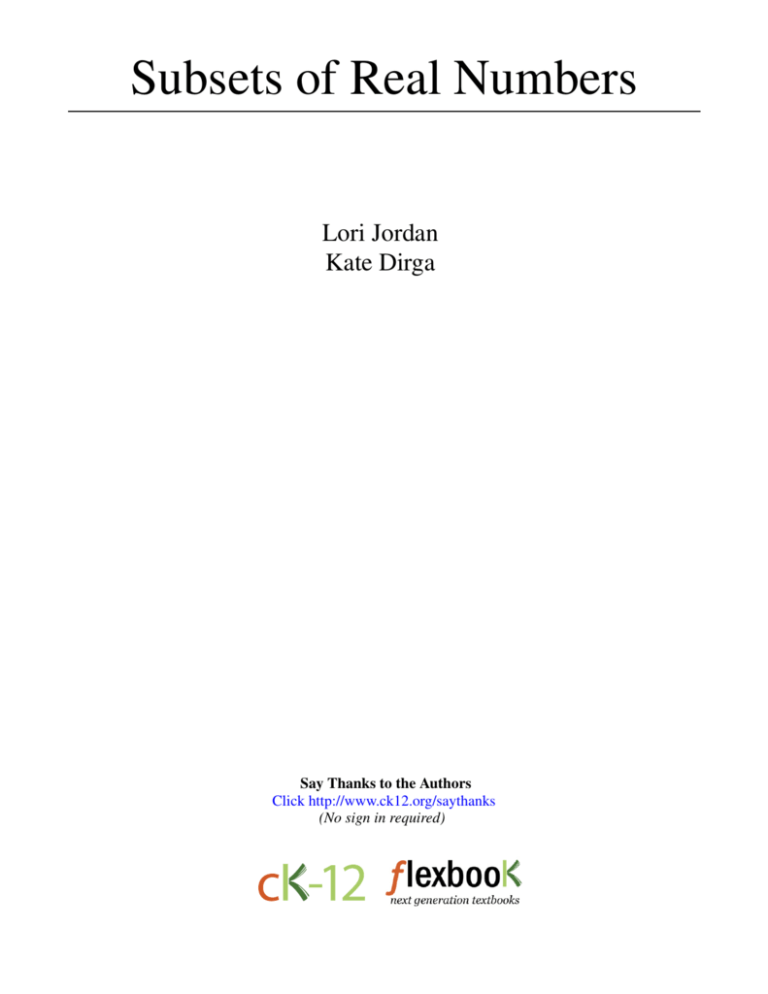
Subsets of Real Numbers Lori Jordan Kate Dirga Say Thanks to the Authors Click http://www.ck12.org/saythanks (No sign in required) To access a customizable version of this book, as well as other interactive content, visit www.ck12.org CK-12 Foundation is a non-profit organization with a mission to reduce the cost of textbook materials for the K-12 market both in the U.S. and worldwide. Using an open-content, web-based collaborative model termed the FlexBook®, CK-12 intends to pioneer the generation and distribution of high-quality educational content that will serve both as core text as well as provide an adaptive environment for learning, powered through the FlexBook Platform®. Copyright © 2014 CK-12 Foundation, www.ck12.org The names “CK-12” and “CK12” and associated logos and the terms “FlexBook®” and “FlexBook Platform®” (collectively “CK-12 Marks”) are trademarks and service marks of CK-12 Foundation and are protected by federal, state, and international laws. Any form of reproduction of this book in any format or medium, in whole or in sections must include the referral attribution link http://www.ck12.org/saythanks (placed in a visible location) in addition to the following terms. Except as otherwise noted, all CK-12 Content (including CK-12 Curriculum Material) is made available to Users in accordance with the Creative Commons Attribution-Non-Commercial 3.0 Unported (CC BY-NC 3.0) License (http://creativecommons.org/ licenses/by-nc/3.0/), as amended and updated by Creative Commons from time to time (the “CC License”), which is incorporated herein by this reference. Complete terms can be found at http://www.ck12.org/terms. Printed: December 30, 2014 AUTHORS Lori Jordan Kate Dirga www.ck12.org C HAPTER Chapter 1. Subsets of Real Numbers 1 Subsets of Real Numbers Here you’ll learn how to identify the subsets of real numbers and place a real number into one of these subsets. The number of survey participants who declined to respond can be represented by the decimal 0.14141414... How would you write this decimal as a fraction? By being able to write a repeating decimal as fraction, we know it is a rational number. Watch This MEDIA Click image to the left or use the URL below. URL: http://www.ck12.org/flx/render/embeddedobject/57616 James Sousa: Identifying Sets of Real Numbers Guidance There are several types of real numbers. You are probably familiar with fractions, decimals, integers, whole numbers and even square roots. All of these types of numbers are real numbers. There are two main types of numbers: real and complex. We will address complex (imaginary) numbers in the Quadratic Functions chapter. TABLE 1.1: Real Numbers Rational Numbers Irrational Numbers Integers Whole Numbers Natural Numbers Any number that can be plotted on a number line. Symbol: R Any number that can be written as a fraction, including repeating decimals. Symbol: Q Real numbers that are not rational. When written as a decimal, these numbers do not end nor repeat. All positive and negative “counting” numbers and zero. Symbol: Z All positive “counting” numbers and zero. All positive “counting” numbers. Symbol: N Examples: 8, 4.67, − 13 , π Examples: − 59 , 18 , 1.3, 16 4 √ √ 3 Example: e, π, − 2, 5 Example: -4, 6, 23, -10 Example: 0, 1, 2, 3, ... Example: 1, 2, 3, ... A counting number is any number that can be counted on your fingers. The real numbers can be grouped together as follows: 1 www.ck12.org Example A What is the most specific subset of the real numbers that -7 is a part of? Solution: -7 is an integer. Example B List all the subsets that 1.3 lies in. Solution: 1.3 is a terminating decimal. Therefore, it is considered a rational number. It would also be a real number. 3 As a fraction, we would write 1 10 because the 3 is in the tenths position after the decimal. Example C True or False: 8 3 is a rational number. Solution: Yes, by definition, because it is written as a fraction. Intro Problem Revisit How do we write 0.14141414.... as a fraction? Let’s devise a step-by-step process. Step 1: Set your repeating decimal equal to x. x = 0.14141414 Step 2: Find the repeating digit(s). In this case 14 is repeating. Step 3: Move the repeating digits to the left of the decimal point and leave the remaining digits to the right. 14.14141414 Step 4: Multiply x by the same factor you multiplied your original repeating decimal to get your new repeating decimal. 2 www.ck12.org Chapter 1. Subsets of Real Numbers 14.14141414 = 100(0.14141414) So, 100x = 14.14141414 Step 5: Solve your system of linear equations for x. (100x = 14.14141414) − (x = 0.14141414) yields: 99x = 14 , so x = 14 99 What about 0.327272727... ? The 0.3 does not repeat. So, rewrite this as 0.727272727... − 0.4 Therefore, the fraction will be: 72 4 − 99 10 2 8 − 11 5 40 22 − 55 55 18 55 Guided Practice 1. What type of real number is √ 5? 2. List all the subsets that -8 is a part of. √ 3. True or False: − 9 is an irrational number. Answers 1. √ 5 is an irrational number because, when converted to a decimal, it does not end nor does it repeat. 2. -8 is a negative integer. Therefore, it is also a rational number and a real number. √ 3. − 9 = −3, which is an integer. The statement is false. Vocabulary Subset A set of numbers that is contained in a larger group of numbers. 3 www.ck12.org Real Numbers Any number that can be plotted on a number line. Rational Numbers Any number that can be written as a fraction, including repeating decimals. Irrational Numbers Real numbers that are not rational. When written as a decimal, these numbers do not end nor repeat. Integers All positive and negative “counting” numbers and zero. Whole Numbers All positive “counting” numbers and zero. Natural Numbers or Counting Numbers Numbers than can be counted on your fingers; 1, 2, 3, 4, ... Terminating Decimal When a decimal number ends. Repeating Decimal When a decimal number repeats itself in a pattern. 1.666..., 0.98989898... are examples of repeating decimals. Explore More What is the most specific subset of real numbers that the following numbers belong in? 1. 2. 3. 4. 5. 6. 5.67 √ − 6 9 5 0 -75 √ 16 List ALL the subsets that the following numbers are a part of. 7. 4 8. 69 9. π Determine if the following statements are true or false. 10. 11. 12. 13. 14. 15. 4 Integers are rational numbers. Every whole number is a real number. Integers are irrational numbers. A natural number is a rational number. An irrational number is a real number. Zero is a natural number. www.ck12.org Chapter 1. Subsets of Real Numbers Rewrite the following repeating decimals as fractions. 16. 17. 18. 19. 20. 0.4646464646... 0.81212121212... 0.35050505050... 2.485485485485485... 1.25141414141414... 5


